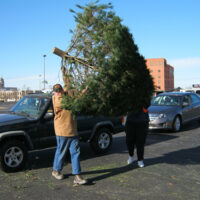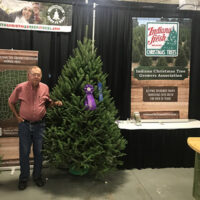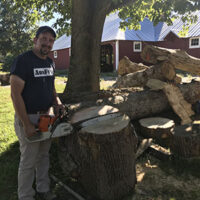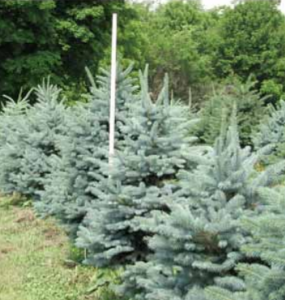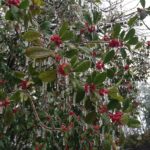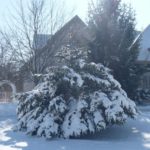 Purdue University - Extension - Forestry and Natural Resources
Purdue University - Extension - Forestry and Natural Resources
Got Nature? Blog
When do you need to discard your real Christmas tree? What options are there in disposing the tree?
Check out these tips from our Purdue experts:
Lenny Farlee, Purdue Extension Forester with Forestry and Natural Resources, in interview with the WLFI news team shares the first steps is to remove all decorations. “Several municipalities here in the area will either take the trees for mulching or composting. So if you don’t want to fool with the tree anymore, that’s a great option. You can just take it to the curb, or certain locations, and they’ll take care of it for you and it gets reused or recycled into usable material,” explains Farlee. Choosing to keep the tree in your backyard is a great wildlife friendly option. Lenny shares how important it is to remove your tree in a timely manner to avoid any fire hazards in your house. The video explains on how you can test your tree to see if it should be discarded. See video and full article for more options: Options for Getting Rid of Real Christmas Tree, wlfi.com.
John Woodmansee, Purdue Extension Educator-Agriculture Natural Resources (ANR), also shares tips in the Purdue Extension article Recycle Your Christmas Tree. If you have permission and/or have access to a private pond you can discard your tree in the pond to improve fish habitat.
Resources:
A Choose-and-Cut Pine and Fir Christmas Tree Case Study, The Education Store, Purdue Extension’s resource center
Living Christmas Trees For The Holidays and Beyond, The Education Store
Tips for First-Time Buyers of Real Christmas Trees, The Education Store
Growing Christmas Trees, The Education Store
Selecting an Indiana-Grown Christmas Tree, The Education Store
Repurposing Your Real Christmas Tree, Purdue Extension News
An Introduction to Trees of Indiana, The Education Store
Native Trees of the Midwest, The Education Store
Shrubs and Woody Vines of Indiana and the Midwest, The Education Store
ID That Tree, Playlist, Subscribe to Purdue Extension – Forestry and Natural Resources YouTube Channel
A Woodland Management Moment, Playlist, Purdue Extension – FNR YouTube Channel
Investing in Indiana Woodlands, The Education Store
Forest Improvement Handbook, The Education Store
Finding help from a professional forester, Indiana Forestry & Woodland Owners Association
District Foresters for 10 plus acres, Indiana Department of Natural Resources
Wood Products, FNR Concentration
Diana Evans, Extension & Web Communications Specialist
Purdue University Department of Forestry and Natural Resources
 A real Christmas tree is an important part of a holiday celebration for many Hoosier households. Consumers have several choices for purchasing a real tree, including pre-cut trees at retail outlets or seasonal sales locations, choose-and-cut trees at Christmas tree farms, or even live trees that can be replanted after the holidays. Purdue Extension offers two publications that can help you select and care for your tree: Tips for First-Time Buyers of Christmas Trees provides advice and direction on how to set up and care for your tree to improve safety and enjoyment. Selecting an Indiana-Grown Christmas Tree provides details on the characteristics of different species of real Christmas trees available in Indiana, as well as care instructions for cut and live Christmas trees.
A real Christmas tree is an important part of a holiday celebration for many Hoosier households. Consumers have several choices for purchasing a real tree, including pre-cut trees at retail outlets or seasonal sales locations, choose-and-cut trees at Christmas tree farms, or even live trees that can be replanted after the holidays. Purdue Extension offers two publications that can help you select and care for your tree: Tips for First-Time Buyers of Christmas Trees provides advice and direction on how to set up and care for your tree to improve safety and enjoyment. Selecting an Indiana-Grown Christmas Tree provides details on the characteristics of different species of real Christmas trees available in Indiana, as well as care instructions for cut and live Christmas trees.
Pre-cut real Christmas trees are available at many retail outlets like garden centers, supermarkets, or seasonal sales locations. If you are looking for local choose-and-cut Christmas tree farms you can consult local media and advertising outlets or the Indiana Christmas Tree Growers Association. Some garden centers and Christmas tree farms may also offer live trees for sale.
If you are considering growing your own Christmas trees for personal use or sale, the Extension publications Growing Christmas Trees and A Choose-and-Cut Pine and Fir Christmas Tree Case Study outline economic and management considerations for growing Christmas trees.
Check out the recorded Facebook LIVE for Ask an Expert: Holidays in the Woods as the experts answer questions regarding Christmas trees along with wildlife you may see while you walk in the woods this winter.
Resources:
A Choose-and-Cut Pine and Fir Christmas Tree Case Study, The Education Store, Purdue Extension’s resource center
Living Christmas Trees For The Holidays and Beyond, The Education Store
Tips for First-Time Buyers of Real Christmas Trees, The Education Store
Growing Christmas Trees, The Education Store
Selecting an Indiana-Grown Christmas Tree, The Education Store
Forest/Timber Playlist, subscribe to Purdue Extension – Forestry and Natural Resources YouTube Channel
Lenny Farlee, Sustaining Hardwood Extension Specialist
Hardwood Tree Improvement and Regeneration Center
Purdue Department of Forestry & Natural Resources
In 1978, Dan Cassens purchased a 10-acre plot of land close to the Purdue campus on which he planted a few Christmas trees as a side project. That plot of land developed into a family Christmas tree farm that Cassens and his wife Vicki have run for more than 40 years.
As the years passed, Dan, now a professor emeritus in the Department of Forestry and Natural Resources after retiring in 2017 following a more than 40-year career at Purdue, enlisted the help of students within the department for both seasonal work and longer-term work on the farm and within his small lumber business.
What started as a few extra hands around the tree farm has turned into a hands-on learning opportunity for more than 20 FNR students each year, teaching workers skills from cutting and handling trees to customer service.
“I don’t remember how it got started; I guess I needed somebody to help me and I probably knew a couple of students that were anxious to work,” Cassens said. “I don’t know how many years it has been going on now, but it keeps getting bigger. Last year at Christmas time we had 20 some students helping us part time with the trees. It’s a good group because they have hard, physical work to do, but then they’ve also got time to sit and talk too.”
The work begins in October to prepare the tree farm for its opening on the Saturday before Thanksgiving, a date determined by customer demand over the years. Cassens Tree Farm has both choose-and-cut and pre-cut trees in species ranging from Canaan fir, Fraser fir and Concolor (White) fir to Scotch pine and white pine and Norway spruce. Once cut, trees have to be shook to remove dead needles, have a fresh cut on the butt of the tree to ensure they stand straight on a tree stand, and many get baled or wrapped, which condenses a tree, making it easier to handle and preventing damage to limbs that may occur in transit.
Cassens does not have prerequisite skills for students who work on the farm, save a willingness to work hard, although there are plenty of jobs on the tree farm that require specialized skills.
“We can use anybody that wants to work hard and has time available,” Cassens said. “We try to find out what their abilities are, because we do need people that can drive trucks and use chainsaws. Chainsaw experience is absolutely critical in part of the operation, but other than that, anybody can work in the barn. It doesn’t require much skill, just hard work. It’s hard to get it all sorted out with 20 students with different hours that they can work and different abilities, but we try to find out their abilities and schedules and try to get them placed. Once we get it going, it’s good.”
Daniel Warner, a 2011 alumnus in wood products manufacturing technology, said Cassens was very understanding when it came to lack of knowledge and miscues.
“My first day helping with the tree farm, I didn’t even know why we were planting these little pine trees (I was thinking lumber not Christmas),” Warner recalled. “I was also recruited for the mortar removal on several tons of vintage bricks. On one hatchet wielding, mortar removing day, I managed to get my truck stuck in Dan’s yard in the mud. Needless to say, the fact that we are still good friends shows that there was a great deal of forgiveness.”
Many of the students who work at Cassens farm are juniors or seniors, but some come back two or three years in a row once a part of the workforce, and often bring friends along to join the crew.
2018 forestry alumnus Ed Oehlman helped at Cassens Trees for five years, beginning the spring of his freshman year.
“I met Dan my freshman year at Purdue and that spring he invited me out to the farm to help him plant Christmas trees and that started my adventure,” Oehlman said. “I got the pleasure of seeing the whole process, from helping him plant trees, spending many hours mowing, sheering trees, spraying and treating trees, and lasting helping sell trees. Selling Christmas Trees is to this day one of the best jobs I’ve ever had. You couldn’t work for better people than Dan and Vicki. The days could be long and active, especially Thanksgiving weekend, but they always made sure you were taken care with little snacks or pizza, sometimes even home made soup. It made the time go by so quick, you’d just get started and before you knew it we were shutting up shop. The best was the fun little gamble we did at the end of the day to guess how many trees we had sold that day, which always made work fun! Working with and for Dan was a great learning experience, and not just about wood/lumber or Christmas trees. I learned so many great life and business skills!”
Charlie Warner, 2021 forestry alumnus and current master’s degree student, worked at Cassens Farm for three and a half years as an undergraduate student and has helped out five seasons overall after being introduced to Cassens and the job his freshman year thanks to Damon McGuckin (sustainable biomaterials 2018) and Oehlman.
“Both Ed and Damon worked for Dan at the tree farm throughout their time at Purdue and told me about him and how he was as both a boss and a professor,” Warner said. “Unfortunately, Dan retired from teaching before I had a chance to take his classes but I made up for it when I started working for him. I started working on the tree farm helping Dan with various jobs, whether it was sawing lumber with his Wood-Mizer, loading and unloading his dry kilns where he dried lumber, cutting down trees and bucking the logs to get them ready for the sawmill and many other jobs and mechanical work around the farm. I learned so much from my few years working for Dan. In fact, he was one of the strongest voices urging me to continue my studies and work towards a master’s degree. Not only did Dan teach me everything there is to know about the wood products industry and more, but he also taught me how to communicate with industry employers. He gave me the skills to make myself extremely marketable to a few of my internship opportunities. Furthermore, he taught me many life lessons.”
Additional Resources
Root Rot in Landscape Plants, The Education Store
Ask The Expert: Tree Inspection, Purdue Extension- FNR YouTube Channel
Ask The Expert: Tree Selection and Planting, Purdue Extension- FNR YouTube Channel
Surface Root Syndrome, The Education Store, Purdue Extension resource center
The Nature of Teaching: Trees of the Midwest, The Education Store
Tree Appraisal and the Value of Trees, The Education Store
Construction and Trees: Guidelines for Protection, The Education Store
ID That Tree: Northern Red Oak
ID That Tree: Red Oak Group
Hardwood Lumber and Veneer Series: Red Oak Group
Morton Arboretum: Northern Red Oak
Red Oak, Native Trees of Indiana River Walk, Fort Wayne Purdue
Fifty Common Trees of Indiana
An Introduction to Trees of Indiana
Native Trees of the Midwest, The Education Store
Shrubs and Woody Vines of Indiana and the Midwest, The Education Store
Investing in Indiana Woodlands, The Education Store
Forest Improvement Handbook, The Education Store
ID That Tree, Purdue Extension-Forestry & Natural Resources (FNR) YouTube playlist
Woodland Management Moment, Purdue Extension-FNR YouTube playlist
Wendy Mayer, FNR Communications Coordinator
Purdue University Department of Forestry and Natural Resources
 With the holidays over the needles are beginning to fall from your natural Christmas tree, continue to spread holiday cheer by returning your tree to nature.
With the holidays over the needles are beginning to fall from your natural Christmas tree, continue to spread holiday cheer by returning your tree to nature.
Jarred Brooke, Extension wildlife specialist, shares a few creative ways you can repurpose and recycle your tree this year.
“Before you throw your used natural Christmas tree in the trash, think about recycling it on your property. Instead of taking up space in the landfill, your tree could decompose naturally while providing cover and food for fish, wildlife or insects,” said Brooke.
No matter how you choose to repurpose your tree, make sure it is free from ornaments and decorations. Do not recycle trees that have been sprayed with “fake” snow or treated with chemicals.
Create a habitat for fish
Throwing used Christmas trees in ponds is a great way to recycle the tree and provide a fish habitat to your pond. The small branches provide hiding spots for small fish to escape from larger predators.
If the pond is frozen with more than four inches of ice, you can drag your tree onto the ice. The tree will fall into place once the ice melts.
You should only add Christmas trees to your ponds or other private ponds with the permission of the pond owner. While they do provide great habitats for fish, they can be a nuisance for fishing as hooks and lines may get caught on branches. It is recommended that you keep trees away from popular fishing areas like docks.
Resources:
Selecting a Real Christmas Tree, Got Nature? Blog, Purdue Extension-Forestry and Natural Resources
A Choose-and-Cut Pine and Fir Christmas Tree Case Study, The Education Store, Purdue Extension’s resource center
Living Christmas Trees For The Holidays and Beyond, The Education Store
Growing Christmas Trees, The Education Store
Selecting an Indiana-Grown Christmas Tree, The Education Store
Forest/Timber Playlist, subscribe to Purdue Extension – Forestry and Natural Resources YouTube Channel
Aquatics & Fisheries, Playlist, Purdue Extension – Forestry and Natural Resources YouTube Channel
Ask an Expert: Pond Wildlife Management, Video, Purdue Extension – FNR YouTube Channel
Ask an Expert: Pond Management: What to Do in Winter, How to Plan for Spring, Video, Purdue Extension – FNR YouTube Channel
Aquatic Plant Management: Identifying and Managing Aquatic Vegetation, The Education Store
Pond and Wildlife Management, Purdue Extension-Forestry and Natural Resources
Jarred Brooke, Wildlife Extension Specialist
Purdue Forestry and Natural Resources
Join Purdue Extension forester Lenny Farlee and wildlife specialist Brian MacGowan as they help you prepare for the holidays while keeping your family and local wildlife safe. This video discusses everything from how to choose and care for a real Christmas tree as well as what to do with it after the season and also how to make wildlife/nature-friendly decorations.
Topics Included:
– What can I do with my tree after Christmas that would benefit wildlife?
– Are artificial structures legal in Indiana lakes?
– What types of items can I collect from the wild for holiday decorations?
– How do I do it in an environmentally responsible way?
– Are there some things I shouldn’t or can’t collect?
– What outdoor holiday decorations can benefit wildlife?
– How do I make it last longer?
– Can I avoid problems with non-target wildlife?
If you have any questions regarding trees, forest management, wildlife, wood products or other natural resource topics, feel free to contact us by using our Ask an Expert web page.
Resources
Selecting an Indiana-Grown Christmas Tree, The Education Store, Purdue Extension resource center
Tips for First-Time Buyers of Real Christmas Trees, The Education Store
ISDA Indiana Grown Christmas Tree Farm map, Indiana Grown
Indiana Christmas Tree Growers Association
Purdue University Invasive Species resources
Indiana DNR Division of Fish and Wildlife for wildlife possession rules
Feed the birds with a DIY wreath, Audubon
Dan Cassens: Tips for First-Time Christmas Tree Buyers, Video, Purdue Agriculture
Dan Cassens: Starting Your Own Christmas Tree Farm, Video
Lenny Farlee, Sustaining Hardwood Extension Specialist
Purdue University Department of Forestry and Natural Resource
Brian MacGowan, Extension Wildlife Specialist
Department of Forestry & Natural Resources, Purdue University
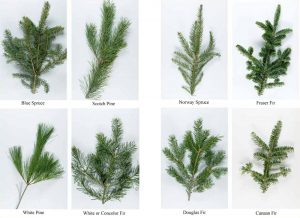 So you are off to select a real Christmas tree this year? The tree characteristics that influence a family’s decision on what species to select can vary greatly. First, many families just want the experience of cutting their own tree. In this case, any appropriately priced and correct sized tree will do. Other consumers may be more demanding in terms of different tree characteristics. These include fragrance of the tree, rather the tree is cone or more globose shaped, needle length, and of course expected needle retention. Color is also to be considered, as well as branch stiffness and cost. These factors all come into play rather the purchaser is aware of them or not. They all interact in one way or another to define the perfect Christmas tree and to create great Christmas memories.
So you are off to select a real Christmas tree this year? The tree characteristics that influence a family’s decision on what species to select can vary greatly. First, many families just want the experience of cutting their own tree. In this case, any appropriately priced and correct sized tree will do. Other consumers may be more demanding in terms of different tree characteristics. These include fragrance of the tree, rather the tree is cone or more globose shaped, needle length, and of course expected needle retention. Color is also to be considered, as well as branch stiffness and cost. These factors all come into play rather the purchaser is aware of them or not. They all interact in one way or another to define the perfect Christmas tree and to create great Christmas memories.
There are about 200 real Christmas Tree Farms producing trees on over 2,500 acres in Indiana. Each year about 90,000 Christmas trees are harvested in Indiana and over a billion dollars in sales are made throughout the U.S. Based on number of trees harvested, Indiana ranks seventh among all states. Most of the farms are choose and cut operations but some wholesale farms, particularly in Northern Indiana, also exist. Real Christmas trees are also sold at retail outlets.
Scotch pine, consisting of several varieties, remains the most commonly grown Christmas tree in Indiana. However, as transportation and communications improved the desire for other species such as the firs and spruces increased. Because climate and soil conditions vary substantially from one end of Indiana to the other, not all species will be found in one area and probably not all on one farm. However, most Indiana farms will have three or four species available.
Scotch pine and white pine are usually the least expensive trees whereas the true fir, are more costly. Douglas fir (not a true fir) and spruce are usually intermediate in cost. The pines will grow on most soils in Indiana and do not require fertilization. Fraser-fir and Canaan fir will only grow on well to moderately well drained soils, require fertilization, and are in relatively short supply as choose and cut trees, especially in southern Indiana. Some farms do not have true firs available in the field. Douglas-fir and spruce trees are intermediate in the care they require while in the field and thus usually intermediate in price. However, growers may have a surplus of a certain species or size of trees and reduce the price to assure that the trees will be sold.
To view the table that presents the common characteristics which help to determine a consumer’s preference for a certain species, as well as read the full article, view the Selecting an Indiana-Grown Christmas Tree publication. However, in the end, it comes down to a family’s preference. The preferred species can also be determined by memories of past Christmases.
In addition to the most commonly produced Indiana species described in the publication, other species may be available. Noble fir and grand fir are shipped in from the west coast and balsam fir from the Lake States and Canada. Balsam fir has been a fairly popular species in the past. Some growers are experimenting with other species such as Korean fir, Turkish fir, and Nordman fir. These are beautiful trees but since it can take at least seven years for these trees to reach Christmas tree size, don’t expect to find many choose and cut trees available just yet.
For more information about Christmas trees or to locate a choose-and-cut tree farm near you, please visit the Indiana Christmas Tree Growers’ website, or the National Christmas Tree Association website.
Resources:
A Choose-and-Cut Pine and Fir Christmas Tree Case Study, The Education Store, Purdue Agriculture’s resource center
Living Christmas Trees For The Holidays and Beyond, The Education Store
Tips for First-Time Buyers of Real Christmas Trees, The Education Store
Growing Christmas Trees, The Education Store
Daniel Cassens, Professor Emeritus
Purdue Department of Forestry and Natural Resources
This looks to be shaping up as a tough winter for us and our trees. Lots of snow and ice are predicted for the Hoosier state and this can be a challenge for our trees and shrubs.
After a heavy snowfall, protect your trees and property with these simple tips:
Do not shake limbs to try to remove snow or ice.
When you find your trees are bending or drooping as a result of ice or snow accumulation, your first instinct is probably to shake the branches or knock the weight off with a broom or something similar. This may cause worse damage or actually cause the branch to snap off. Stop right there! Healthy tree branches are flexible, so knocking off the accumulation of snow or ice accretion may cause them to “snap” back, potentially damaging their food and water transport system. The results of the damage may not be evident until next spring.
Trees that tend to suffer the worst damage as a result of snow and ice are upright evergreens, like arborvitae and juniper, and clump trees, like birch. And, when it comes to ice, age does not make a tree stronger; younger trees are better at actually overcoming damage in ice storms.
Hire a Professional.
Safely remove broken limbs.
Broken and hanging branches can be a threat to people and property. If a limb breaks off from the weight of ice or snow and remains in the tree canopy, have it removed and the remaining stub properly pruned to the branch collar as soon as weather allows. The tree will recover better when properly pruned. For undamaged limbs bending under the weight of ice or snow, don’t prune as a means of correcting the situation. Be patient. It takes time for wood fibers in the limbs to return to its natural position.
Always be mindful of walking or parking under branches loaded down by snow or ice as they may snap and fall, causing injury or damage. If a limb breaks and becomes entangled in power lines, notify your utility company immediately. Never approach a downed power line or a branch touching a utility line.
If there is substantial damage to your tree, have an arborist examine damaged branches and limbs for signs of weakness and injury for reparations. It is best to always hire an ISA Certified Arborist. To find an arborist in your area, visit the website, www.treesaregood.org
How can you help prevent ice damage to trees? Proper pruning is one way. Particularly important is the removal of poor branch attachments and weak branch structure in the tree, prior to winter. For more information on pruning, download the publication, Tree Pruning Essentials.
Full article published in the Purdue Landscape Report.
Resources
Avoid Deadly Risk of Dying Ash Trees with Timely Tree Removal, Got Nature? Purdue Extension-FNR
New Hope for Fighting Ash Borer, Got Nature? Purdue Extension-FNR
Invasive Pest Species: Tools for Staging and Managing EAB in the Urban Forest, Got Nature?
Emerald Ash Borer, Purdue Extension-Entomology
Emerald Ash Borer Cost Calculator – Purdue Extension Entomology
Corrective Pruning for Deciduous Trees, The Education Store, Extension Publications
Lindsey Purcell, Chapter Executive Director
Indiana Arborist Association
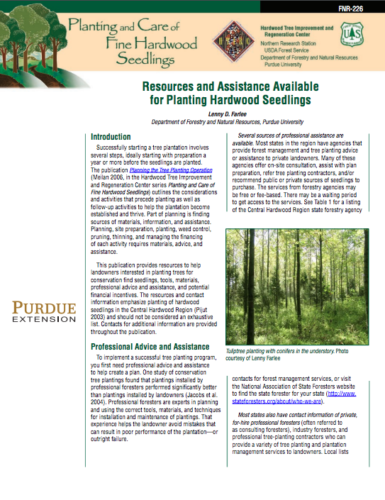 Successfully starting a tree plantation involves several steps, ideally starting with preparation a year or more before the seedlings are planted. This updated publication with current resources titled Resources and Assistance Available for Planting Hardwood Seedlings, landowners can find valuable information about planting trees for conservation, such as resources, contact information, tools, professional advice and assistance and financial incentives.
Successfully starting a tree plantation involves several steps, ideally starting with preparation a year or more before the seedlings are planted. This updated publication with current resources titled Resources and Assistance Available for Planting Hardwood Seedlings, landowners can find valuable information about planting trees for conservation, such as resources, contact information, tools, professional advice and assistance and financial incentives.
Resources:
Ordering Seedlings from the State Forest Nursery System, Got Nature?, Purdue Extension-FNR
Instructions for Ordering Tree Seedlings – Indiana DNR Division of Forestry
Importance of Hardwood Tree Planting – The Education Store, Purdue Extension Resource Center
Forest Improvement Handbook – The Education Store
Designing Hardwood Tree Plantings for Wildlife – The Education Store
Lenny D Farlee, Sustaining Hardwood Extension Specialist
Purdue University Department of Forestry and Natural Resources
It’s that time of year again. The desperate rush to find the ‘perfect’ tree for your annual year-end celebration is very real. Unfortunately, you chose a tree last year that died within a month and was disappointingly dull. This year, you are going to do your homework to find the best tree available.
Home preparations:
- Tree Location: Select an area out of direct sunlight and away from the heating vents in your house for the tree. Excessive sunlight and heat will cause your tree to fade and dry out more quickly.
- Ceiling height: Measure your ceiling heights and take into account the height of your tree stand and the tree topper or you’ll have to make excessive cuts in your tree to adjust for the differences. Write down these measurements.
- Tree shape: Visualize the shape of the tree that best fits the space you have available (tall and thin, short and broad) and keep that in mind. Certain tree types are more expensive therefore knowing your budget will help ensure you purchase the perfect tree for your household. Measure the width of the space and write down these measurements.
- Tree stand: Anticipate needing to support your tree stand and acquire a piece of plywood that you can bolt the stand to keep it level. Measure the inside diameter of the tree stand and write down the measurements.
Choosing a tree farm:
- Buy from a local farm if at all possible. These trees are bred to be hardy and to remain fresh longer.
Bring to the farm:
- List of required measurements for your perfect tree.
- A large unbreakable ornament to view branch spacing (ensures your ornaments will hang straight).
- Measuring tape to measure prospective trees before getting them home.
- Thick gloves for handling your tree as the needles may be sharp and the bark rough on your bare hands.
- An old blanket that can cover the truck bed or car roof to protect it from sap.
- Rope, twine, bungee cords, and twist ties to secure the tree to the car if these items are not provided by the tree farm.
Species selection:
- Each tree species is different so careful selection is important: Soft needle species (pines, firs) are best for homes with small children while hard needle species (spruce) are the adult choice.
- Firs often have shorter needles, strong stems, and well-spaced branches making it easier to hang lights and decorations.
 *click image to enlarge
*click image to enlarge
At the tree farm:
- Check freshness: Bend a needle with your fingers (firs snap, pines ben).
- Gentle run your hand over the branch from inside to out or if possible, gently bounce the tree on the cut end. If a few interior needles come off, it is probably fresh; if many exterior needles fall off, choose a different tree.
- Remove and crush a few needles in your hand, if there is little scent choose another tree.
- The tree should have even coloration 360° around and needles should be fresh (shiny, green) and not old (dried out, brown).
When you and your tree get home:
- Protect Your Floor– Place a plastic or other waterproof covering on the floor where your tree will stand so you don’t ruin the carpet or get watermarks on hardwood flooring.
- Put down waterproof coverings or plastic sheeting under the tree skirt to prevent ruining the carpet or hardwood floor if water is spilled.
- Make a fresh cut at the base of the tree, take off ½” from the base so that tree can absorb more water (slows needle drop and helps maintain tree color) and immediately place the tree upright in the stand with lukewarm water.
- Trim any low-hanging branches that hit furniture or are too thin for ornaments parallel to the floor. Keep them in a bucket of water before using as decorations.
- Secure your tree to the wall or heavy furniture if you have pets and children that could knock it over or heavy ornaments that may sway the tree.
- Ensure that your tree stand always has water in it.
- Take a photo of your tree when set up and secured as a reminder for the following year.
After the holidays:
- Recycle your tree through your local waste management company.
- Trees can also be chipped for mulch. Never burn your tree because of the likelihood of starting a fire.
Examples of holiday tree types:
Resources:
Which Real Indiana Christmas Tree Will You Select? – Got Nature?, Purdue FNR-Extension
Living Christmas Trees For The Holidays and Beyond, The Education Store
Tips for First-Time Buyers of Real Christmas Trees, The Education Store
Growing Christmas Trees, The Education Store
Shaneka Lawson, USDA Forest Service/HTIRC Research Plant Physiologist/Adjunct Assistant Professor
Purdue University Department of Forestry and Natural Resources
 Indiana landowners have access to high quality, inexpensive trees and shrubs for conservation plantings through the DNR Division of Forestry nursery program. Order forms are now available on the Division of Forestry web page.
Indiana landowners have access to high quality, inexpensive trees and shrubs for conservation plantings through the DNR Division of Forestry nursery program. Order forms are now available on the Division of Forestry web page.
You may also be able to access hard-copy order forms at your local Purdue Cooperative Extension Service or Soil and Water Conservation District office. Submit your order form to the state nursery system prior to October 2, 2017 for the best chance to get the seedlings you need. The nursery will start processing orders on October 3rd and some species tend to sell out quickly. Orders will be accepted from October 3, 2017 to May 1, 2018. Seedlings will be available for pickup at the nursery or delivery for an additional fee in the Spring of 2018.
Seedlings from the DNR Division of Forestry Nursery program are for conservation plantings in Indiana. Private nurseries are also available to provide seedlings for conservation and other types of plantings, like Christmas trees or landscaping. For a listing of private nurseries and the products they offer, visit the National Nursery and Seed Directory.
Resources:
Instructions for Ordering Tree Seedlings – Indiana DNR Division of Forestry
National Nursery and Seed Directory – USDA Forest Service
Web Soil Survey – USDA Natural Resources Conservation Service
Importance of Hardwood Tree Planting – The Education Store, Purdue Extension Resource Center
Designing Hardwood Tree Plantings for Wildlife – The Education Store
Got Nature? – Purdue Forestry & Natural Resources
Lenny D Farlee, Sustaining Hardwood Extension Specialist
Purdue University Department of Forestry and Natural Resources
Recent Posts
- Tips on How You Can Recycle Your Christmas Tree
Posted: January 2, 2024 in Ask the Expert, Christmas Trees, Forestry, Forests and Street Trees, How To, Wildlife - Selecting a Real Christmas Tree
Posted: November 20, 2023 in Christmas Trees, Forestry, How To - Cassens Trees Provides Learning Ground for FNR Student Workers
Posted: January 9, 2023 in Christmas Trees, Forestry, Forests and Street Trees, Plants, Urban Forestry, Woodlands - Repurposing Your Real Christmas Tree
Posted: January 2, 2022 in Aquaculture/Fish, Aquatic/Aquaculture Resources, Christmas Trees, Forests and Street Trees, How To, Urban Forestry, Wildlife - Ask An Expert: Holidays in the Wild
Posted: January 7, 2021 in Christmas Trees, Forestry, Forests and Street Trees, How To, Plants - Which Real Indiana Christmas Tree Will You Select?
Posted: December 9, 2019 in Christmas Trees, Forestry, How To - Winter Weather Tree Tips
Posted: February 5, 2019 in Christmas Trees, Forestry, Forests and Street Trees, How To, Nature of Teaching, Safety - Publication: Resources and Assistance Available for Planting Hardwood Seedlings
Posted: February 8, 2018 in Christmas Trees, Forestry, Forests and Street Trees, How To, Plants, Timber Marketing - Picking out a Holiday Tree
Posted: December 5, 2017 in Christmas Trees, Forests and Street Trees, How To, Woodlands - Ordering Seedlings from the State Forest Nursery System
Posted: August 4, 2017 in Christmas Trees, Plants
Archives
Categories
- Alert
- Aquaculture/Fish
- Aquatic/Aquaculture Resources
- Ask the Expert
- Christmas Trees
- Community Development
- Disease
- Drought
- Forestry
- Forests and Street Trees
- Gardening
- Got Nature for Kids
- Great Lakes
- How To
- Invasive Animal Species
- Invasive Insects
- Invasive Plant Species
- Land Use
- Natural Resource Planning
- Nature of Teaching
- Plants
- Podcasts
- Ponds
- Publication
- Safety
- Spiders
- Timber Marketing
- Uncategorized
- Urban Forestry
- Webinar
- Wildlife
- Wood Products/Manufacturing
- Woodland Management Moment
- Woodlands
